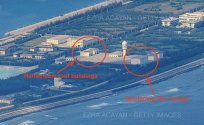China can detect opposing fleet but the opposing fleet has a much harder time detecting the Chinese fleet. Some regime only has 6 active optical recon satellites and 1 active SAR satellite. This is insufficient for constant overwatch of moving targets. They have more ELINT satellites in the NOSS constellation (24) but RF listening is much less precise than imaging.I feel there is so many ways a naval fleet can be detected, even in the middle of the ocean. Obviously, the role of surveillance satellites has been discussed to death, but there seem to be a belief that you need a large number of low-orbit platforms to do the job, given they have individually only a limited hovering time over an area, and high-resolution images naturally cover a smaller area. From my understanding, to monitor a specific area continuously (not to establish a viable kill-chain), high-orbit geostationary satellites can do the job despite the relatively low fidelity of the optical information from a high altitude. Once the movement of an opposing force has been identified, the available low-orbit platforms will know where to look, and these should be able to collect higher-resolution data more suitable for weapon guidance.
In an age where real-time information (and integration of information) is so critical to success in warfare, the normalisation of ostensibly neutral countries providing intel to belligerents opens up a can of worms. It seems the most critical part is not the shooters, but the sensors. If a Russian ship or plane sees a US naval force on its way to lift a PRC siege on Taiwan, what is the US going to do? Sink that ship and broaden the war? Or risk having it communicate that information to Beijing, which will then undoubtedly focus its ISR assets on the right area? How could it even prove the target was giving its location away afterwards?
What about civilian ships crossing paths with a naval force on the move? While commercial shipping or cruise firms probably won't want to get in trouble by supplying information on the whereabouts of military assets, there's no guarantee that every single person on the vessel will abide by the same rule. All it takes is one person - be it a worker or passenger - revealing their whereabouts after seeing a supercarrier and its escorts. Moreover, what if belligerents deliberately send fishing ships (possibly without clear markings) all over the place as part of a civil-military effort to enhance maritime surveillance?
Pondering all these questions lead me to believe that there is nowhere to hide.
China has 100+ Yaogan satellites (split 1/3 between optical, SAR and ELINT) and 70+ Jilin satellites (all optical imaging). Nowhere is beyond the sight of the PLA.

